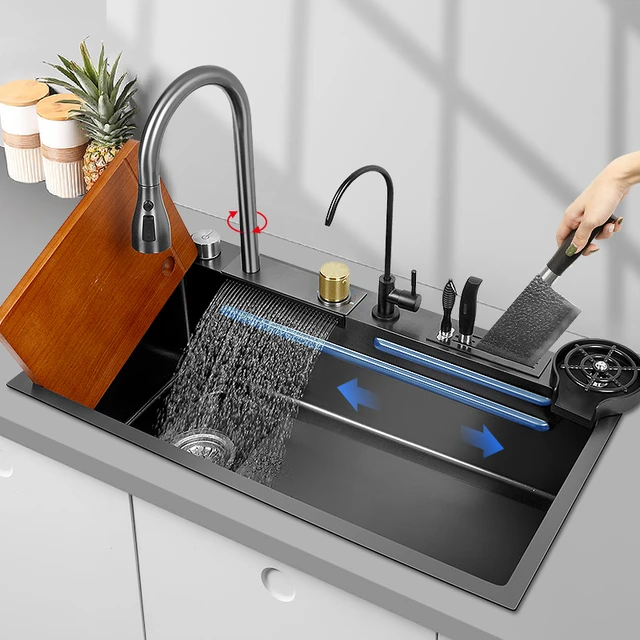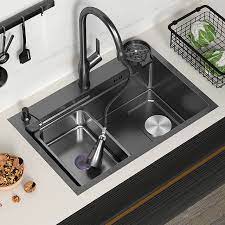 Introduction:
Introduction:
Granite kitchen sinks have gained popularity in recent years for their durability, aesthetic appeal, and functional design. Made from a composite material that combines natural granite stone with resin, these sinks offer various advantages for homeowners. In this comprehensive guide, we will explore the features, benefits, and considerations of granite kitchen sinks. Whether you’re remodeling your kitchen or looking to upgrade your sink, this guide will provide valuable insights into the world of granite kitchen sinks.
 Beauty and Aesthetics
Beauty and Aesthetics
Natural Stone Look:
Granite kitchen sinks mimic the natural beauty and elegance of granite stone.
The various colors and patterns available can complement a range of kitchen styles, from modern to traditional.
Classic and Timeless Aesthetics:
Granite is a classic and timeless choice for kitchen sinks.
Its natural appeal adds a touch of sophistication and style to any kitchen decor.
Durability and Performance
Scratch and Chip Resistance:
Granite kitchen sinks are highly durable and resistant to scratches and chips.
The composite material used in their construction helps protect against everyday wear and tear.
Stain Resistance:
Granite sinks are resistant to stains that commonly occur in the kitchen, such as coffee, tea, and food coloring.
The non-porous surface of the sink prevents the absorption of liquids, making cleaning and maintenance easier.
Heat Resistance:
Granite is heat-resistant, allowing hot pots and pans to be placed directly in the sink without causing damage.
This quality provides convenience and versatility in the kitchen.
 Maintenance and Care
Maintenance and Care
Cleaning:
Granite kitchen sinks are relatively easy to clean.
Regular cleaning with mild soap and water is sufficient to maintain their appearance and hygiene.
Avoid Harsh Chemicals:
To preserve the integrity and finish of granite sinks, it is important to avoid using harsh chemicals, abrasive cleaners, or metal scouring pads.
Gentle cleaners and non-abrasive sponges are recommended for routine maintenance.
Considerations for Installation
Sink Size and Configuration:
Consider the size and configuration of your kitchen space to determine the appropriate size and style of the granite sink.
Single-bowl and double-bowl options are available, depending on your specific needs and preferences.
Undermount or Drop-in:
Granite sinks can be installed as undermount or drop-in sinks.
Undermount sinks provide a clean and seamless look, while drop-in sinks are easier to install and replace.
Supporting Cabinetry and Countertops:
Ensure that the supporting cabinetry and countertops can handle the weight of the granite sink.
Consult with a professional installer or contractor to ensure proper installation and support.
Cost Considerations
Initial Investment:
Granite kitchen sinks may have a higher initial cost compared to other sink materials.
However, their durability and long lifespan make them a worthwhile investment.
Return on Investment:
The aesthetic appeal and durability of granite sinks can add value to your home and potentially increase its resale value.
Are often seen as a desirable feature by homebuyers.
 Granite kitchen sinks can be paired with various types of faucets:
Granite kitchen sinks can be paired with various types of faucets:
Can be paired with various types of faucets, depending on the style and functionality you desire. Here are some considerations when selecting a faucet to complement a granite kitchen sink:
Finish:
Pay attention to the finish of the faucet and ensure it complements the color and pattern of the granite sink. Popular faucet finishes for granite sinks include stainless steel, brushed nickel, chrome, and oil-rubbed bronze. Choose a finish that matches or contrasts with the sink to create a cohesive and visually appealing look.
Style:
Consider the style or design of the faucet and choose one that harmonizes with the overall aesthetic of the kitchen. Whether you prefer a modern, minimalist, traditional, or industrial look, there are faucets available in various styles and shapes to suit your preferences.
Mounting Options:
Determine the mounting configuration of the granite sink to select an appropriate faucet. Granite sinks typically come in undermount, drop-in, or farmhouse styles. Undermount sinks usually allow for more flexibility in faucet selection, while drop-in or farmhouse sinks may have pre-drilled holes for specific faucet types.
Size and Reach:
Consider the size and length of the faucet, especially if you have a larger or deeper sink. Ensure the faucet has adequate height and reach to comfortably accommodate the size of your granite sink. For deeper sinks, you may want to opt for a taller faucet or a model with a pull-down sprayer for easier access.
Functional Features:
Think about the functional features you desire in a faucet, such as a single-handle or double-handle design, the inclusion of a sprayer, or touchless operation. Choose a faucet that meets your specific needs and enhances the functionality of your kitchen.
When pairing a faucet with a granite kitchen sink, it’s important to consider the overall design, functionality, and compatibility. Take into account the sink’s color, shape, and installation type, as well as your personal preferences for faucet design and features.
While granite kitchen sinks offer many advantages, there are a few potential drawbacks to consider:
Cost:
Granite sinks tend to be more expensive compared to other sink materials, such as stainless steel or porcelain. The cost of the sink itself, as well as the installation and maintenance, can be higher, making it less budget-friendly for some homeowners.
Weight:
Granite sinks are heavy due to the natural stone material, which can pose challenges during installation. The weight requires proper support and reinforcement underneath the sink cabinet to prevent any structural issues.
Fragility:
While granite is a durable material, it is still susceptible to chipping or cracking if heavy objects are dropped into the sink. Care should be taken when handling sharp or heavy kitchen tools to avoid damaging the sink. Using a protective mat or layer at the bottom of the sink can help minimize the risk of damage.
Maintenance:
Granite sinks require regular maintenance to keep them in optimal condition. They should be properly sealed to prevent staining and water absorption, and it is important to clean them regularly with non-abrasive cleaners to avoid scratching the surface. Failure to maintain and care for the sink properly may result in discoloration or damage over time.
Limited Color Options:
While granite offers a range of beautiful natural colors, the options may still be more limited compared to other sink materials. If you have a specific color scheme or design vision for your kitchen, you may have fewer choices with granite sinks.
By considering these potential drawbacks, you can make an informed decision about whether a granite kitchen sink is the right choice for your kitchen. It’s helpful to weigh the advantages and disadvantages based on your budget, lifestyle, and aesthetic preferences.
 Conclusion:
Conclusion:
Granite kitchen sinks provide durability, style, and practicality for modern kitchens. With their natural beauty, resistance to scratches and stains, and heat resistance, granite sinks offer numerous advantages. By understanding the features, benefits, and considerations outlined in this guide, you can confidently choose a granite kitchen sink that complements your kitchen design and meets your functional needs. With proper care and maintenance, your granite sink will continue to enhance the aesthetic appeal and functionality of your kitchen for years to come.
